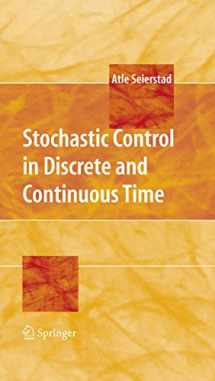
Stochastic Control in Discrete and Continuous Time
ISBN-13:
9781441945693
ISBN-10:
1441945695
Edition:
2009
Author:
Atle Seierstad
Publication date:
2011
Publisher:
Springer
Format:
Paperback
232 pages
FREE US shipping
Book details
ISBN-13:
9781441945693
ISBN-10:
1441945695
Edition:
2009
Author:
Atle Seierstad
Publication date:
2011
Publisher:
Springer
Format:
Paperback
232 pages
Summary
Stochastic Control in Discrete and Continuous Time (ISBN-13: 9781441945693 and ISBN-10: 1441945695), written by authors
Atle Seierstad, was published by Springer in 2011.
With an overall rating of 3.5 stars, it's a notable title among other
books. You can easily purchase or rent Stochastic Control in Discrete and Continuous Time (Paperback) from BooksRun,
along with many other new and used
books
and textbooks.
And, if you're looking to sell your copy, our current buyback offer is $0.54.
Description
This book contains an introduction to three topics in stochastic control: discrete time stochastic control, i. e. , stochastic dynamic programming (Chapter 1), piecewise - terministic control problems (Chapter 3), and control of Ito diffusions (Chapter 4). The chapters include treatments of optimal stopping problems. An Appendix - calls material from elementary probability theory and gives heuristic explanations of certain more advanced tools in probability theory. The book will hopefully be of interest to students in several ?elds: economics, engineering, operations research, ?nance, business, mathematics. In economics and business administration, graduate students should readily be able to read it, and the mathematical level can be suitable for advanced undergraduates in mathem- ics and science. The prerequisites for reading the book are only a calculus course and a course in elementary probability. (Certain technical comments may demand a slightly better background. ) As this book perhaps (and hopefully) will be read by readers with widely diff- ing backgrounds, some general advice may be useful: Don’t be put off if paragraphs, comments, or remarks contain material of a seemingly more technical nature that you don’t understand. Just skip such material and continue reading, it will surely not be needed in order to understand the main ideas and results. The presentation avoids the use of measure theory.


We would LOVE it if you could help us and other readers by reviewing the book
Book review

Congratulations! We have received your book review.
{user}
{createdAt}
by {truncated_author}


